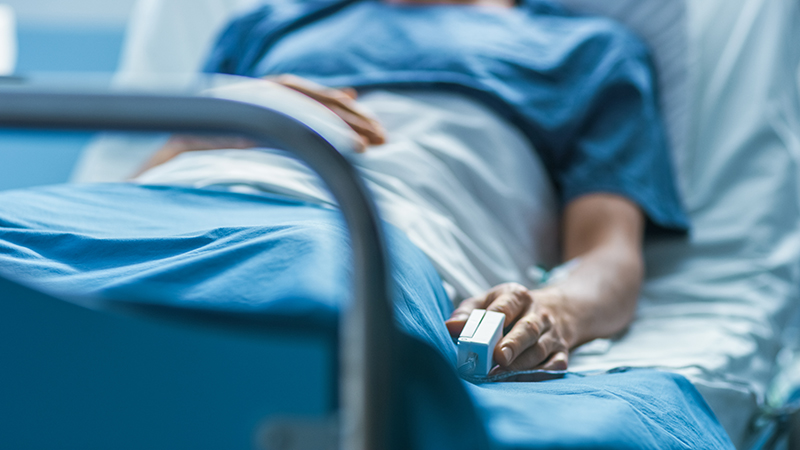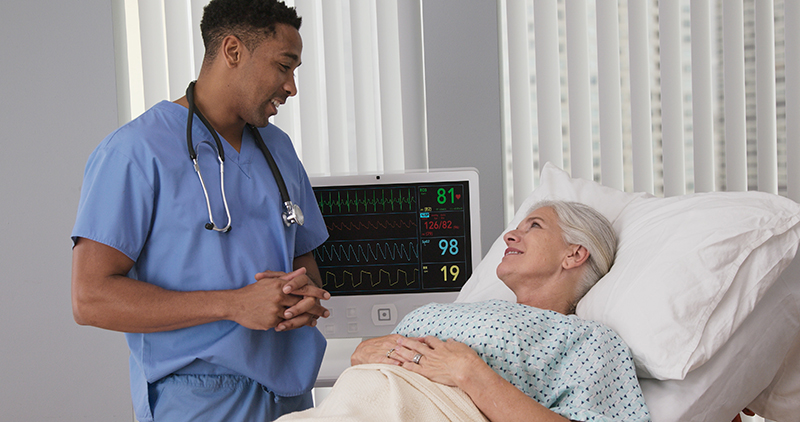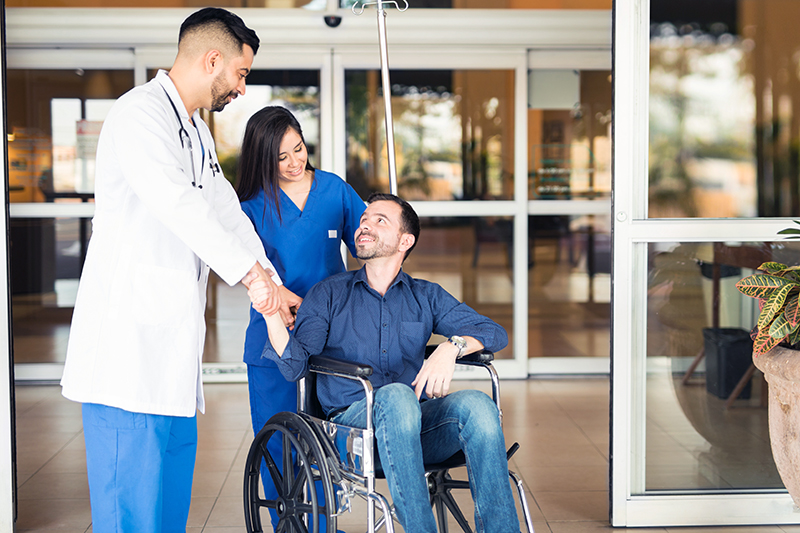Hospital to Home
Needing to be in the hospital can cause patients with bronchiectasis and nontuberculous mycobacterial (NTM) lung disease to feel scared, anxious, or worried. A hospital stay may be needed for those patients who are unable to recover quickly from an exacerbation or become sick for other health reasons. It is important to remember that you can do all the right things to avoid exacerbations or illness and still need a hospital stay.
The information on this page is meant to serve as a guide for preparing for a hospital stay and the transition back home after the hospital.

When you should seek emergency medical attention:
There are certain signs and/or symptoms that indicate you may need to seek emergency attention. Those signs and symptoms include:
- Chest pain
- Rapid breathing or heart rate
- Blue or gray color of lips and nails
- Disorientation or confusion
- Slurred speech
What you should bring to the hospital:
- Driver’s license or photo id
- Health insurance card
- Copy of power of attorney, living will, and/or advance directive
- Complete list of your medicines (include supplements, vitamins, and settings for sleep equipment if that applies to you)
- Important phone numbers (include emergency contact)
- List of allergies to medicines
- Eyeglasses (especially if you need them to read and sign documents)
Optional items to bring (to make your visit more comfortable):
- Cell phone and charger
- Pajamas (loose fitting and preferably that button up the front)
- Toiletries
- Pillow
- Robe and slippers
- Underwear
- Socks
- Cozy blanket
- Ear plugs or headphones
What to expect in the hospital:
Emergency Department (ED) – The ED is a busy place of healing and treating people of all ages, with different illnesses or injuries. If you arrive on your own, you will be asked to sign in and register. An ED staff member will call you back to triage (trEE-ahzh). Triage is an area of the ED where a nurse or other specialty trained health care person will measure of your vital signs and ask you further questions about your current health and health history. Your vital signs include your heart rate, your temperature, your breathing rate and your blood pressure. The emergency department sees patients in order of severity. This means those who are the sickest or who have the most serious injuries are seen before those less sick or injured, regardless of when they arrived. Unfortunately, if there are many patients waiting to be seen by a doctor, you may be required to wait, depending on how sick you are.1

Treatment – Once you have been seen by an ED doctor, a plan for treatment will be made. Depending on how your body responds to treatment in the ED, you may be treated and released to go home. Plans will then be made for further treatment and follow-up with your primary care or pulmonary doctor. If you need further care and/or to be examined, tested or observed more, you may be admitted to the hospital. The length of your stay in the hospital will be decided by your doctors, based on health checks done each day.1
- Medicines – In a hospital setting, there are more options for giving medicines. Your doctor will decide the right course of medicines to treat your illness. Be certain to mention any allergies to medicines that you may have. Breathing medicines may be given with a nebulizer (neb-you-lie-zer) or by inhaler and may be used with multiple forms of airway clearance therapy. The use of intravenous (in trah vean us) or “IV” (a small tube in your vein) antibiotic (ant tee by ah tick) medicines may be required to fight infections.
- Oxygen – Sometimes when a patient is ill, or their lungs are not working well, extra or “supplemental” oxygen may be given. Oxygen can be delivered via a nasal cannula (can-you-luh) or specific types of face masks. Your oxygen levels will be checked throughout the day to make sure you are getting enough oxygen in your body.
- Non-Invasive Ventilation – If breathing is becoming increasingly difficult and is not improving with treatment, your doctor may suggest non-invasive (nAHn-in-vAY-siv) ventilation (ven ti lay shun). In non-invasive ventilation a snug mask is placed on your face over your mouth and/or nose and is connected to a machine that puts air into your lungs. This machine helps to ease the work the lungs are doing, helping them to heal.
- Ventilation – If breathing becomes extremely difficult and/or you are not improving with non-invasive ventilation, you may be placed on a mechanical (muh can nuh cul) ventilator. This process is done by giving you a medicine to make you go to sleep. Then a tube is placed either in your nose or mouth that goes directly to your lungs. The tube is connected to a machine that does all the breathing for you. Mechanical ventilation allows the body to rest and the lungs to be fully supported as you get better. This type of ventilation is only done when necessary.
- Rest – It is important when you are in the hospital to get as much rest as you can. Frequent naps will be necessary as treatment for those that are hospitalized is “around the clock.” Patients are often awoken for therapy, tests, and medicine.

Other considerations
- Know your rights –The Patient Bill of Rights are rules set up by the American Hospital Association that protect patients and make sure every patient gets good, quality health care. Knowing your rights as a patient may help to guide you in making good decisions about your care.2
- Advance directives/living will – An advance directive is a document in which a person gives directions about their medical care in before or “in advance” of them becoming sick. It also states who the patient chooses to make decisions about their care if they are unable to make them for themselves. A living will is a document that states what types of medical treatment a person is willing to receive or decline in an event of an emergency.2
- Visitors – Although it is always nice to have visits from loved ones and friends, try to limit visits to those that are necessary. Frequent visitors may make it difficult to get rest throughout the day.
Before you leave the hospital
Planning for Discharge – Before you can leave the hospital it is wise to gather information and ask questions to make your move back home easier. Being able to leave the hospital is called being “discharged.” Your “discharge team” consists of you, your doctor (who approves discharge from the hospital), a nurse/social worker (who plans discharge) and possibly a family member or caregiver (who may be needed to give care).3
Questions to ask:
- Where will you be discharged to? (Can you go home by yourself or with home health visits? Or will you need a rehabilitation [re ha bii lee tay shun) facility?) ***If you are not being discharged home, do not be discouraged. You may need to build strength and continue healing for a short time before you return home. The goal is to make sure you are strong enough to safely return home.
- Do you need any medical equipment in your home to make things easier or safer? Examples include: a shower seat, walker, scooter, CPAP equipment (for sleep apnea), etc.
- Will you need to wear oxygen at home? If so, what equipment do you need and when will it be provided?
- Will you continue the same medicines you were on in the hospital, or should you go back to your original home routine?
- Are you taking your medicines correctly?
- When should you follow up with your primary care doctor and pulmonologist? Has this appointment been scheduled for you?
- Will you need any rehabilitation (e.g., physical therapy or pulmonary rehab)?
- What are some signs and symptoms that you should watch for so that you do not get sick again?
- Are there any nutritional or dietary guidelines that you need to follow?
- Are there limits or restrictions on what you can do? Are you able to exercise?
- When can you go back to work? (if you work)
- Will you receive a copy of the discharge instructions with important contact information?
- What signs or symptoms might mean you need to come back to the hospital?

Prior to leaving the hospital
- Review the discharge instructions carefully.
- Review the medicines that have been prescribed and make sure all the medicines that you were taking at home, before your hospital stay, are listed. If any are not listed, be sure to find out why.
- Have a loved one or friend bring you comfortable clothes to leave the hospital in.
- Plan to have a loved one or friend to take you home.
After you are home
When you return home, you will likely feel many emotions. Happiness that you have returned home, worry that you may become sick again, and/or overwhelmed with your new medication and treatment schedule. All of these feelings are completely normal.
Here are some steps to getting back to normal.
- Fill all the medications that you are prescribed.
- Continue with your airway clearance routine, as suggested by your doctor.
- Get your rest. Regaining your health and strength is a lot of work. Be sure to take time to sleep and recover.
- Follow up with all your doctors for advice on next steps.
- Eat well. Good nutrition is fuel to your recovery. Eat foods that will help nourish you and help you regain your strength.
- Start exercising. Once you are cleared for exercise and activity, start slowly. Increase as you feel more confident, build strength, and increase endurance.
References
1The COPD Foundation. COPD in the hospital and the transition back to home. COPD Foundation website. Accessed April 27, 2021. https://www.copdfoundation.org/Learn-More/I-am-a-Person-with-COPD/Hospital-to-Home.aspx.
2National Institutes of Health (NIH) Clinical Center. Legal, ethical, and safety issues. Your rights and responsibilities. NIH website. Updated June 26, 2017. Accessed April 27, 2021. https://cc.nih.gov/participate/patientinfo/legal1.html.
3United Hospital Fund. Hospital to home discharge guide. Next Step in Care website. Published 2014. Accessed April 27, 2021.https://www.nextstepincare.org/uploads/File/Guides/Hospital/Hospital_to_Home_Guide/Hospital_to_Home.pdf.